Global Trends in Scientific Research on Pediatric Obesity
Abstract
1. Introduction
2. Materials and Methods
3. Results
3.1. Annual Evolution
3.2. Journals of Publication
3.3. Subject Categories
3.4. Countries of Publication
3.5. Keyword Analysis
4. Discussion
5. Conclusions
Author Contributions
Funding
Conflicts of Interest
References
- NCD Risk Factor Collaboration. Trends in adult body-mass index in 200 countries from 1975 to 2014: A pooled analysis of 1698 population-based measurement studies with 19·2 million participants. Lancet 2016, 387, 1377–1396. [Google Scholar] [CrossRef]
- Global Burden of Disease Obesity Collaborators; Afshin, A.; Forouzanfar, M.H.; Reitsma, M.B.; Sur, P.; Estep, K.; Lee, A.; Marczak, L.; Mokdad, A.H.; Moradi-Lakeh, M.; et al. Health Effects of Overweight and Obesity in 195 Countries over 25 Years. N. Engl. J. Med. 2017, 377, 13–27. [Google Scholar] [PubMed]
- Basterra-Gortari, F.J.; Beunza, J.J.; Bes-Rastrollo, M.; Toledo, E.; Martín García-López, M.; Martínez-González, M.A. Increasing Trend in the Prevalence of Morbid Obesity in Spain: From 1.8 to 6.1 per Thousand in 14 Years. Rev. Esp. Cardiol. 2011, 64, 424–426. [Google Scholar] [CrossRef]
- Wang, Y.; Lobstein, T. Worldwide trends in childhood overweight and obesity. Int. J. Pediatric Obes. 2006, 1, 11–25. [Google Scholar] [CrossRef] [PubMed]
- Kelly, T.; Yang, W.; Chen, C.-S.; Reynolds, K.; He, J. Global burden of obesity in 2005 and projections to 2030. Int. J. Obes. 2005, 32, 1431–1437. [Google Scholar] [CrossRef] [PubMed]
- World Health Organization. Obesity: Preventing and Managing the Global Epidemic; World Health Organization: Geneva, Switzerland, 2000; Available online: https://apps.who.int/iris/handle/10665/42330 (accessed on 16 December 2021).
- Hruby, A.; Hu, F.B. The Epidemiology of Obesity: A Big Picture. PharmacoEconomics 2015, 33, 673–689. [Google Scholar] [CrossRef] [PubMed]
- Qasim, A.; Turcotte, M.; de Souza, R.J.; Samaan, M.C.; Champredon, D.; Dushoff, J.; Speakman, J.R.; Meyre, D. On the origin of obesity: Identifying the biological, environmental and cultural drivers of genetic risk among human populations. Obes. Rev. 2017, 19, 121–149. [Google Scholar] [CrossRef]
- Grundy, S.M. Multifactorial causation of obesity: Implications for prevention. Am. J. Clin. Nutr. 1998, 67, 563S–572S. [Google Scholar] [CrossRef]
- Chung, S.T.; Onuzuruike, A.U.; Magge, S.N. Cardiometabolic risk in obese children. Ann. N. Y. Acad. Sci. 2018, 1411, 166–183. [Google Scholar] [CrossRef]
- Lehnert, T.; Sonntag, D.; Konnopka, A.; Riedel-Heller, S.; König, H.-H. Economic costs of overweight and obesity. Best Pract. Res. Clin. Endocrinol. Metab. 2013, 27, 105–115. [Google Scholar] [CrossRef]
- Simmonds, M.; Llewellyn, A.; Owen, C.G.; Woolacott, N. Predicting adult obesity from childhood obesity: A systematic review andmeta-analysis. Obes. Rev. 2016, 17, 95–107. [Google Scholar] [CrossRef] [PubMed]
- Simmonds, M.; Burch, J.; Llewellyn, A.; Griffiths, C.; Yang, H.; Owen, C.; Duffy, S.; Woolacott, N. The use of measures of obesity in childhood for predicting obesity and the development of obesity-related diseases in adulthood: A systematic review and meta-analysis. Health Technol. Assess. 2015, 19, 1–336. [Google Scholar] [CrossRef]
- Caballero, B. Obesity prevention in children: Opportunities and challenges. Int. J. Obes. 2004, 28, S90–S95. [Google Scholar] [CrossRef] [PubMed]
- Karnik, S.; Kanekar, A. Childhood obesity: A global public health crisis. Int. J. Prev. Med. 2012, 3, 1–7. [Google Scholar]
- Birch, L.L.; Ventura, A.K. Preventing childhood obesity: What works? Int. J. Obes. 2009, 33, S74–S81. [Google Scholar] [CrossRef] [PubMed]
- Pandita, A.; Sharma, D.; Pandita, D.; Pawar, S.; Kaul, A.; Tariq, M. Childhood obesity: Prevention is better than cure. Diabetes Metab. Syndr. Obes. Targets Ther. 2016, 9, 83–89. [Google Scholar] [CrossRef] [PubMed]
- Deal, B.J.; Mark DHuffman, M.D.; Helen Binns, H.; Stone, N.J. Childhood Obesity Requires New Strategies for Prevention. Adv. Nutr. 2020, 11, 1071–1078. [Google Scholar] [CrossRef]
- Gehanno, J.-F.; Gehanno, B.; Schuers, M.; Grosjean, J.; Rollin, L. Analysis of Publication Trends in Childhood Obesity Research in PubMed Since 1945. Child. Obes. 2019, 15, 227–236. [Google Scholar] [CrossRef]
- Durieux, V.; Gevenois, P.A. Bibliometric Indicators: Quality Measurements of Scientific Publication. Radiology 2010, 255, 342–351. [Google Scholar] [CrossRef]
- Batagelj, V.; Andrej, M.; Matjaz, Z. Network Analysis of Texts; Department of Theoretical Computer Science, Inst. of Mathematics, Physics and Mechanics, University of Ljubljana: Ljubljana, Eslovenia, 2002. [Google Scholar]
- World Health Organization. Obesity and Overweigh. Available online: https://www.who.int/news-room/fact-sheets/detail/obesity-and-overweight (accessed on 16 December 2021).
- Visser, L.; De Boer, M.A.; De Groot, C.J.M. Analysis of Publication Interest on Preterm Birth Over Two Decades. Matern. Child Health J. 2019, 23, 1392–1399. [Google Scholar] [CrossRef]
- De Groot, C.J.M.; Van Leeuwen, T.; Mol, B.W.J.; Waltman, L. A Longitudinal Analysis of Publications on Maternal Mortality. Paediatr. Périnat. Epidemiol. 2015, 29, 481–489. [Google Scholar] [CrossRef] [PubMed]
- Kutluk, M.G.; Danis, A. Bibliometric analysis of publications on pediatric epilepsy between 1980 and 2018. Child’s Nerv. Syst. 2020, 37, 617–626. [Google Scholar] [CrossRef] [PubMed]
- Lubans, D.R.; Jones, R.; Okely, A.D.; Salmon, J.; Baur, L.A. Review of Australian Childhood Obesity Research Funding 2010–2013. Health Promot. J. Aust. 2013, 24, 155. [Google Scholar] [CrossRef] [PubMed]
- Wilde, P.; Morgan, E.; Roberts, J.; Schpok, A.; Wilson, T. Relationship between funding sources and outcomes of obesity-related research. Physiol. Behav. 2012, 107, 172–175. [Google Scholar] [CrossRef] [PubMed]
- Kaiser, K.; Cofield, S.S.; Fontaine, K.R.; Glasser, S.; Thabane, L.; Chu, R.; Ambrale, S.; Dwary, A.D.; Kumar, A.; Nayyar, G.; et al. Is funding source related to study reporting quality in obesity or nutrition randomized control trials in top-tier medical journals? Int. J. Obes. 2011, 36, 977–981. [Google Scholar] [CrossRef][Green Version]
- Kim, S.; Li, B.; Rosoklija, I.; Johnson, E.K.; Yerkes, E.; Chu, D.I. Federal research funding and academic productivity in pediatric urology: From early career to research independence. J. Pediatr. Urol. 2019, 15, 233–239. [Google Scholar] [CrossRef]
- Sandström, U.; Besselaar, P.V.D. Funding, evaluation, and the performance of national research systems. J. Inf. 2018, 12, 365–384. [Google Scholar] [CrossRef]
- Leydesdorff, L.; Bornmann, L.; Wagner, C.S. The Relative Influences of Government Funding and International Collaboration on Citation Impact. J. Assoc. Inf. Sci. Technol. 2018, 70, 198–201. [Google Scholar] [CrossRef]
- Loomba, R.S.; Anderson, R.H. Are we allowing impact factor to have too much impact: The need to reassess the process of academic advancement in pediatric cardiology? Congenit. Heart Dis. 2018, 13, 163–166. [Google Scholar] [CrossRef]
- Kumar, S.; Kelly, A.S. Review of Childhood Obesity: From Epidemiology, Etiology and Comorbidities to Clinical Assessment and Treatment. Mayo Clin. Proc. 2017, 92, 251–265. [Google Scholar] [CrossRef]
- Bass, R.; Eneli, I. Severe childhood obesity: An under-recognised and growing health problem. Postgrad. Med. J. 2015, 91, 639–645. [Google Scholar] [CrossRef] [PubMed]
- Lee, E.Y.; Yoon, K.-H. Epidemic obesity in children and adolescents: Risk factors and prevention. Front. Med. 2018, 12, 658–666. [Google Scholar] [CrossRef] [PubMed]
- Skelton, J.A.; Palakshappa, D.; Moore, J.B.; Irby, M.B.; Montez, K.; Rhodes, S.D. Community engagement and pediatric obesity: Incorporating social determinants of health into treatment. J. Clin. Transl. Sci. 2019, 4, 279–285. [Google Scholar] [CrossRef] [PubMed]
- Shreve, M.; Scott, A.; Vowell Johnson, K. Adequately Addressing Pediatric Obesity: Challenges Faced by Primary Care Providers. South Med. J. 2017, 110, 486–490. [Google Scholar] [CrossRef]
- De Giuseppe, R.; Di Napoli, I.; Porri, D.; Cena, H. Pediatric Obesity and Eating Disorders Symptoms: The Role of the Multidisciplinary Treatment. A Systematic Review. Front. Pediatr. 2019, 7, 123. [Google Scholar] [CrossRef]
- Tyler, J.M.; Fruh, S.M.; Mulekar, M.S. Pediatric obesity screening and prevention strategies. J. Contin. Educ. Nurs. 2014, 45, 199–200. [Google Scholar] [CrossRef]
- Brüne, M.; Hochberg, Z. Secular trends in new childhood epidemics: Insights from evolutionary medicine. BMC Med. 2013, 11, 226. [Google Scholar] [CrossRef]
- Watson, P.; Wiers, R.W.; Hommel, B.; Ridderinkhof, K.R.; de Wit, S. An associative account of how the obesogenic environment biases adolescents’ food choices. Appetite 2016, 96, 560–571. [Google Scholar] [CrossRef]
- Small, L.; Aplasca, A. Child Obesity and Mental Health: A Complex Interaction. Child Adolesc. Psychiatr. Clin. N. Am. 2016, 25, 269–282. [Google Scholar] [CrossRef]
- Rankin, J.; Matthews, L.; Cobley, S.; Han, A.; Sanders, R.; Wiltshire, H.D.; Baker, J.S. Psychological consequences of childhood obesity: Psychiatric comorbidity and prevention. Adolesc. Health Med. Ther. 2016, 7, 125–146. [Google Scholar] [CrossRef]
- Ring-Dimitriou, S.; Krustrup, P.; Coelho-E-Silva, M.; Mota, J.; Seabra, A.; Rego, C.; Mazur, A.; Vlachopapadopoulou, E.; Caroli, M.; Frelut, M.-L.; et al. Could sport be part of pediatric obesity prevention and treatment? Expert conclusions from the 28th European Childhood Obesity Group Congress. J. Sport Health Sci. 2019, 8, 350–352. [Google Scholar] [CrossRef] [PubMed]
- King, A.C.; Perez-Escamilla, R.; Vorkoper, S.; Anand, N.; Rivera, J. Childhood obesity prevention across borders: The promise of U.S.-Latin American research collaboration. Obes. Rev. 2021, 22, e13238. [Google Scholar] [CrossRef]
- Swinburn, B.; Sacks, G.; Vandevijvere, S.; Kumanyika, S.; Lobstein, T.; Neal, B.; Barquera, S.; Friel, S.; Hawkes, C.; Kelly, B.; et al. INFORMAS (International Network for Food and Obesity/non-communicable diseases Research, Monitoring and Action Support): Overview and key principles. Obes. Rev. 2013, 14 (Suppl. 1), 1–12. [Google Scholar] [CrossRef] [PubMed]
- Whelan, J.; Love, P.; Romanus, A.; Pettman, T.; Bolton, K.; Smith, E.; Gill, T.; Coveney, J.; Waters, E.; Allender, S. A map of community-based obesity prevention initiatives in Australia following obesity funding 2009–2013. Aust. N. Z. J. Public Health 2015, 39, 168–171. [Google Scholar] [CrossRef] [PubMed][Green Version]
- Ogden, C.L.; Fryar, C.D.; Martin, C.B.; Freedman, D.S.; Carroll, M.D.; Gu, Q.; Hales, C.M. Trends in obesity prevalence by race and Hispanic origin—1999–2000 to 2017–2018. JAMA 2020, 324, 1208–1210. [Google Scholar] [CrossRef]
- Hales, C.M.; Fryar, C.D.; Carroll, M.D.; Freedman, D.S.; Ogden, C.L. Trends in obesity and severe obesity prevalence in US youth and adults by sex and age, 2007–2008 to 2015–2016. JAMA 2018, 319, 1723–1725. [Google Scholar] [CrossRef]
- Telama, R.; Yang, X.; Viikari, J.; Valimaki, I.; Wanne, O.; Raitakari, O. Physical activity from childhood to adulthood: A 21-year tracking study. Am. J. Prev. Med. 2005, 28, 267–273. [Google Scholar] [CrossRef]
- Gewin, V. Data sharing: An open mind on open data. Nature 2016, 529, 117–119. [Google Scholar] [CrossRef]
- Mennes, M.; Biswal, B.B.; Castellanos, F.X.; Milham, M.P. Making data sharing work: The FCP/INDI experience. NeuroImage 2013, 82, 683–691. [Google Scholar] [CrossRef]
- Bachrach, C.A.; King, R.B. Data sharing and duplication. Is there a problem? Arch. Pediatrics Adolesc. Med. 2004, 158, 931–932. [Google Scholar] [CrossRef]
- Aleixandre-Benavent, R.; Ferrer-Sapena, A.; Silvia, C.F.; Peset, F.; García, A. Policies regarding public availability of published research data in pediatrics journals. Scientometrics 2019, 118, 439–451. [Google Scholar] [CrossRef]
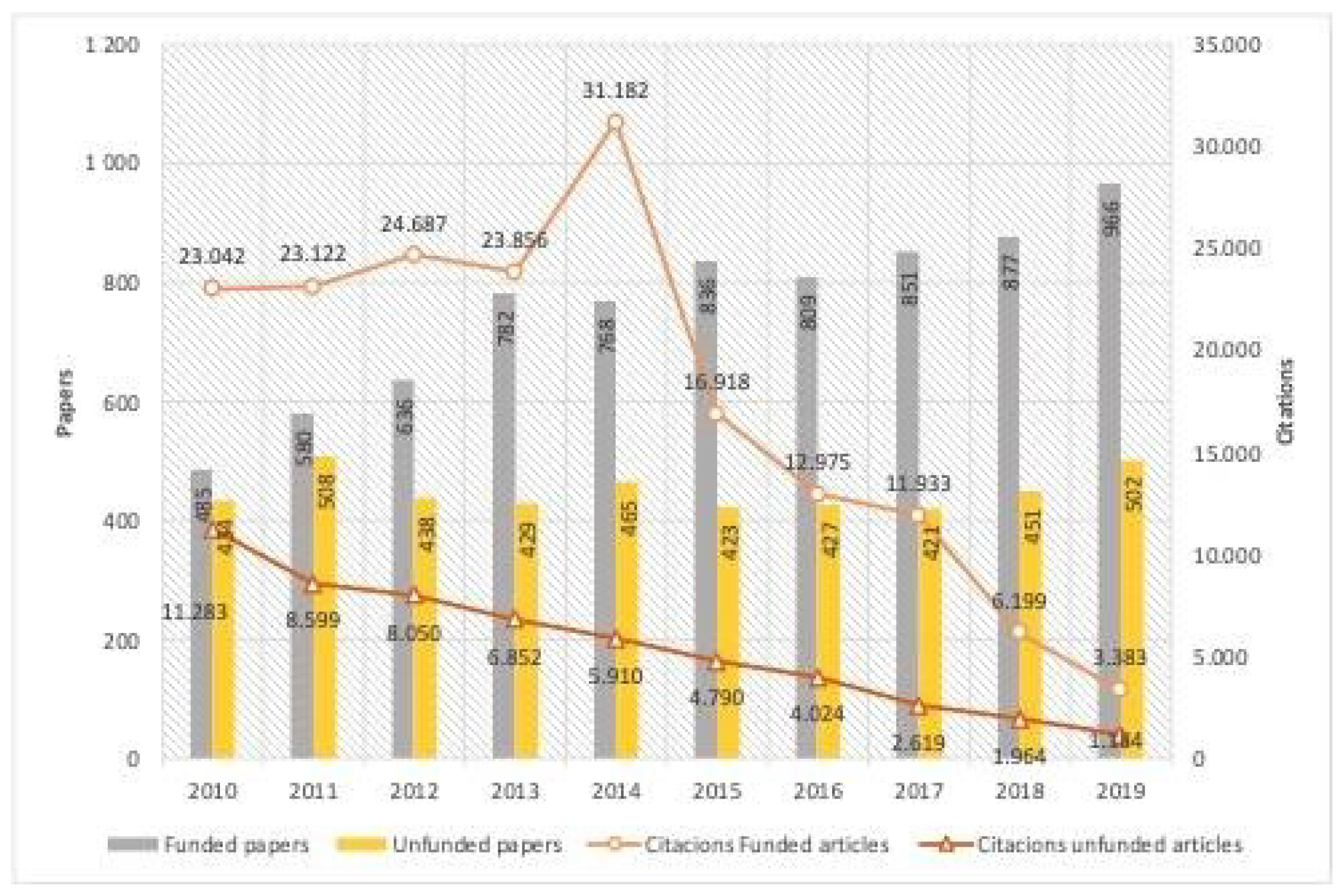
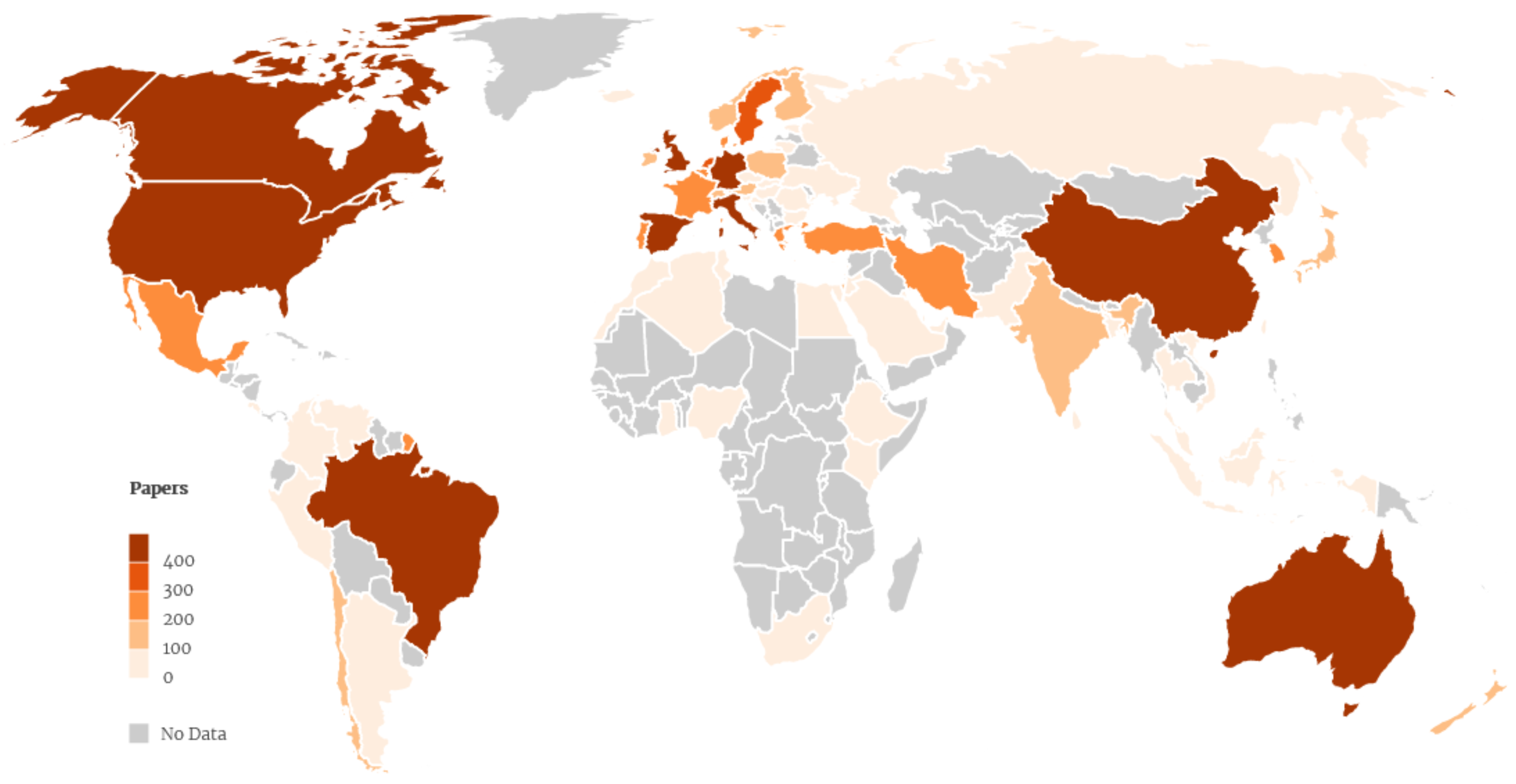
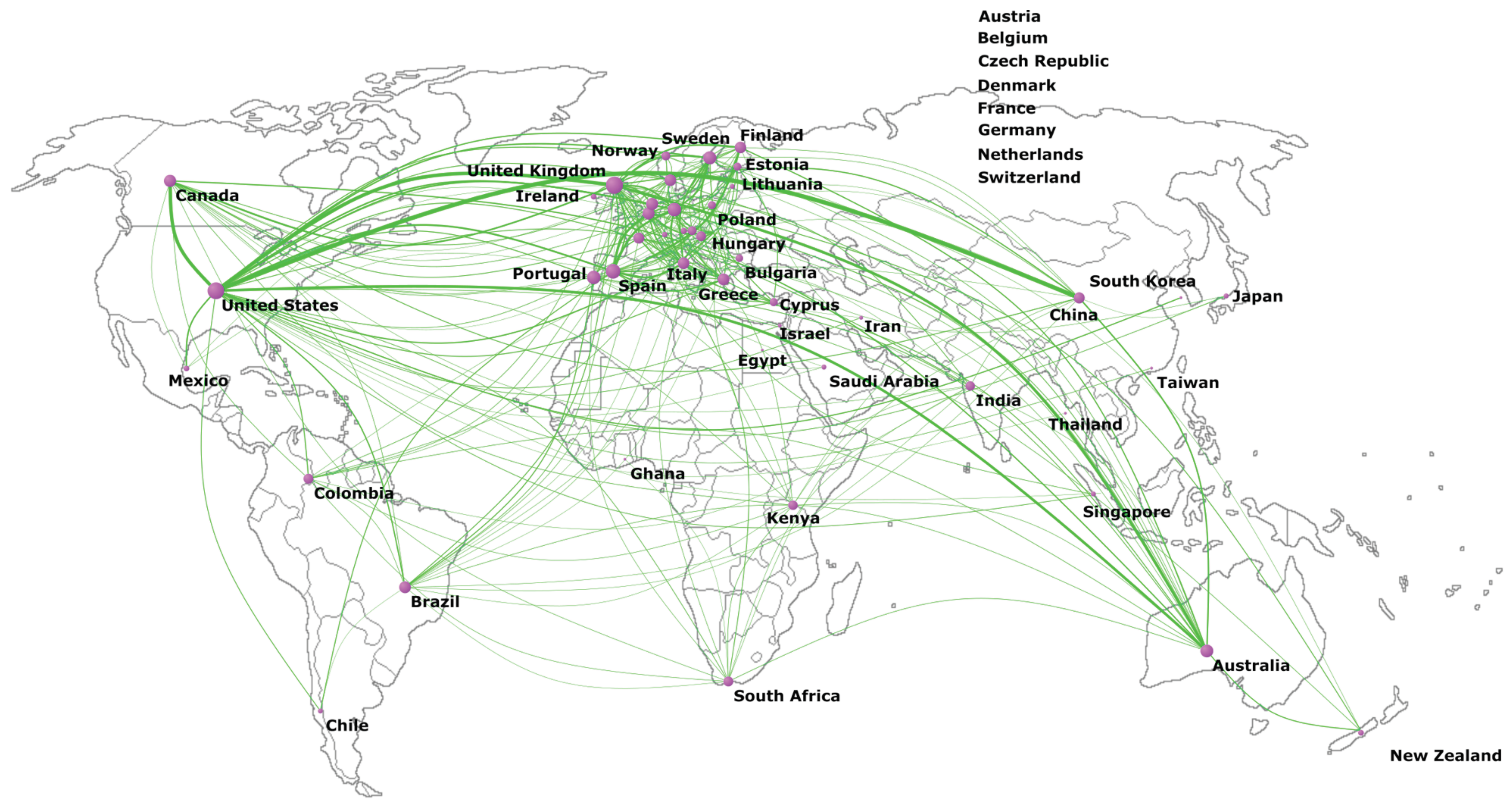
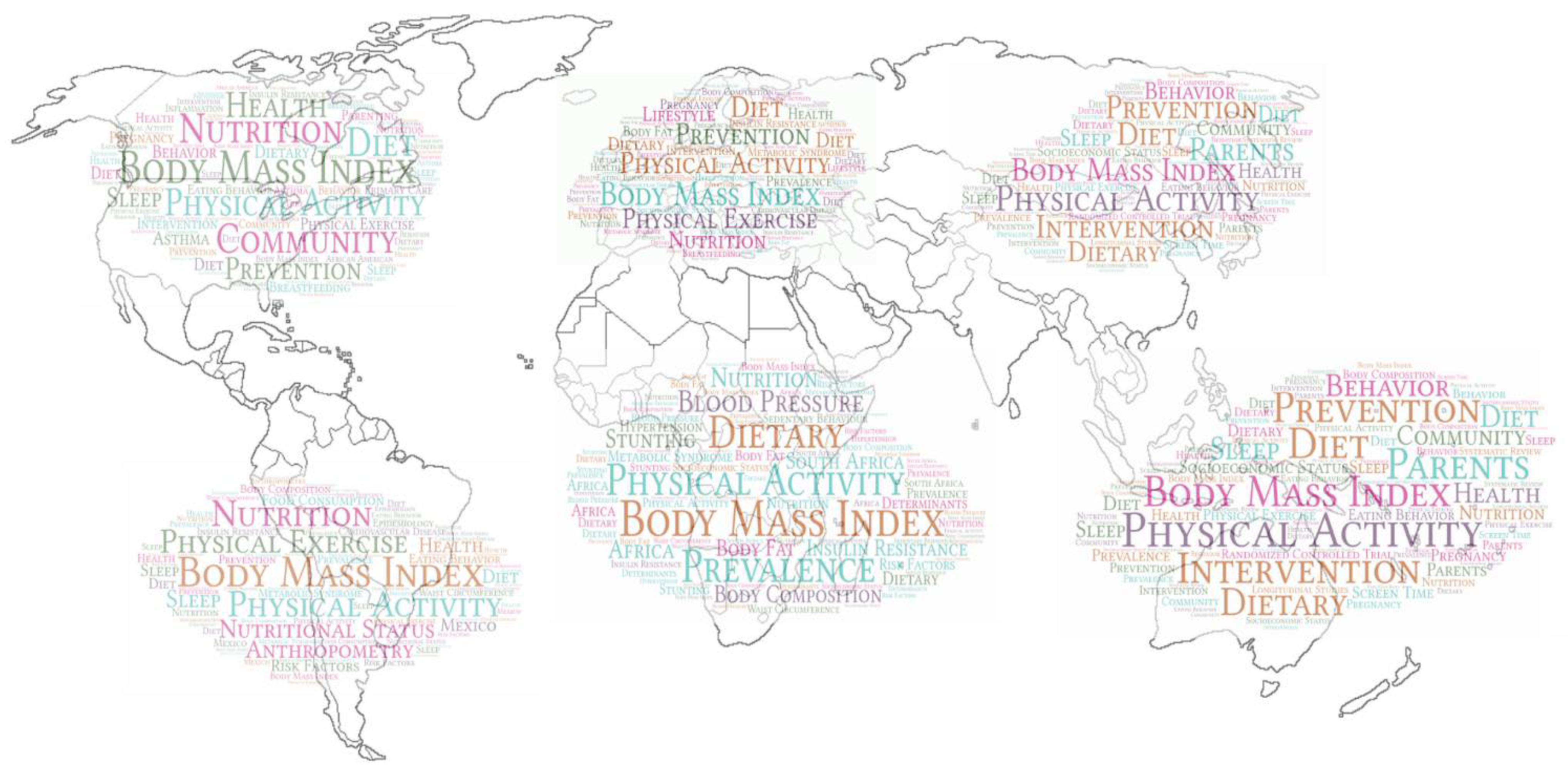
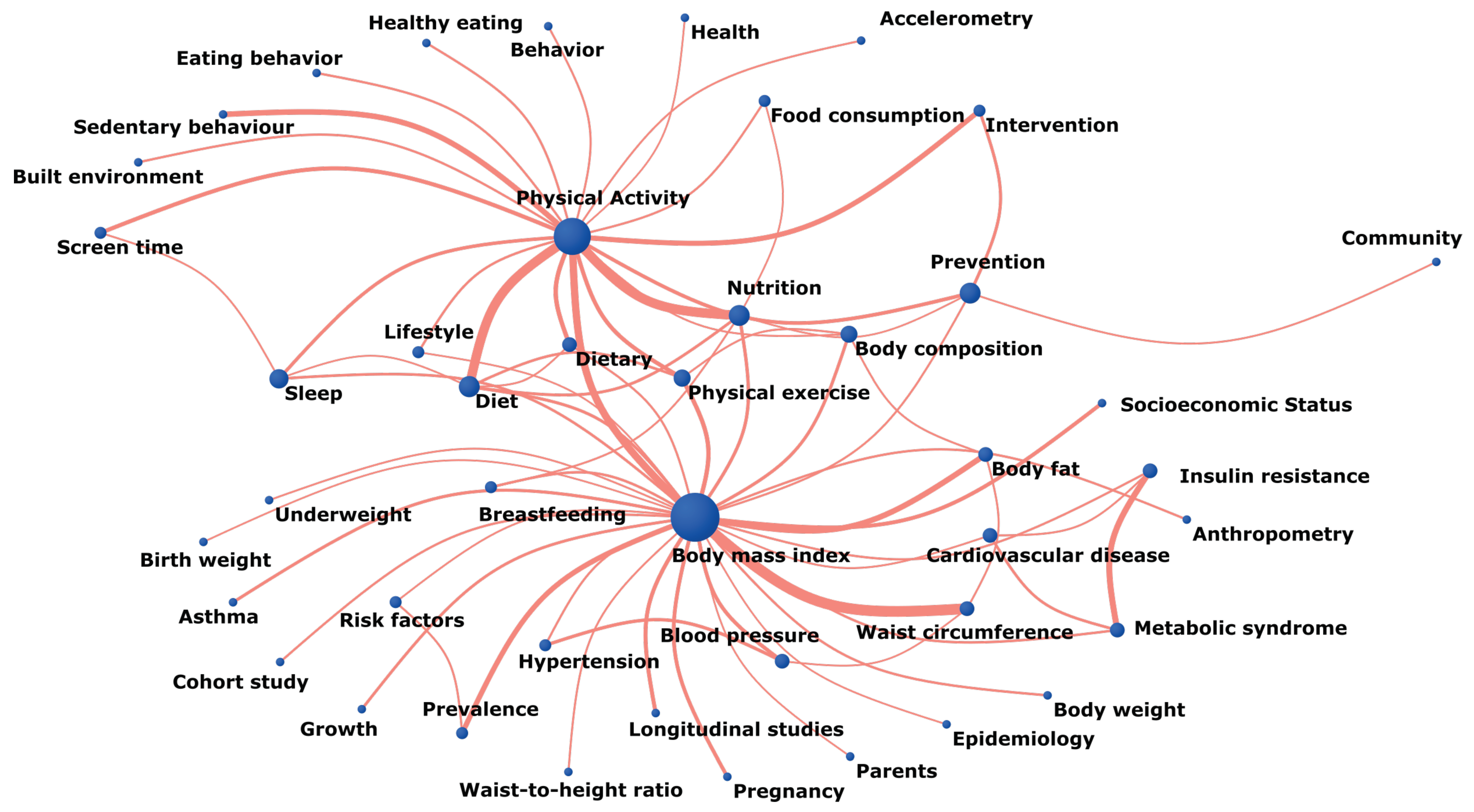
| Years | Totals | % | Citations | % | Funded Papers | % | Citations Funded Articles | Unfunded Papers | % | Citations Unfunded Articles | % |
|---|---|---|---|---|---|---|---|---|---|---|---|
| 2010 | 919 | 7.6% | 34,325 | 14.8% | 485 | 52.8% | 23,042 | 434 | 47.2% | 11,283 | 32.9% |
| 2011 | 1088 | 9.0% | 31,721 | 13.6% | 580 | 53.3% | 23,122 | 508 | 46.7% | 8599 | 27.1% |
| 2012 | 1074 | 8.9% | 32,737 | 14.1% | 636 | 59.2% | 24,687 | 438 | 40.8% | 8050 | 24.6% |
| 2013 | 1211 | 10.0% | 30,708 | 13.2% | 782 | 64.6% | 23,856 | 429 | 35.4% | 6852 | 22.3% |
| 2014 | 1233 | 10.2% | 37,092 | 15.9% | 768 | 62.3% | 31,182 | 465 | 37.7% | 5910 | 15.9% |
| 2015 | 1259 | 10.4% | 21,708 | 9.3% | 836 | 66.4% | 16,918 | 423 | 33.6% | 4790 | 22.1% |
| 2016 | 1236 | 10.2% | 16,999 | 7.3% | 809 | 65.5% | 12,975 | 427 | 34.5% | 4024 | 23.7% |
| 2017 | 1272 | 10.5% | 14,552 | 6.3% | 851 | 66.9% | 11,933 | 421 | 33.1% | 2619 | 18.0% |
| 2018 | 1328 | 11.0% | 8163 | 3.5% | 877 | 66.0% | 6199 | 451 | 34.0% | 1964 | 24.1% |
| 2019 | 1468 | 12.1% | 4567 | 2.0% | 966 | 65.8% | 3383 | 502 | 34.2% | 1184 | 25.9% |
| Totals | 12,088 | 100.0% | 232,572 | 100.0% | 7590 | 62.8% | 177,297 | 4498 | 37.2% | 55,275 | 23.8% |
| Journals | Papers | Citations | Citations Papers | Funded | % Funded | Unfunded Papers | % Unfunded Papers | Impact Factor | 5-Year Impact Factor | Subject Categories | Q | Most Productive Countries |
|---|---|---|---|---|---|---|---|---|---|---|---|---|
| International Journal of Obesity | 299 | 10,441 | 34.92 | 261 | 87.3% | 38 | 12.7% | 4.419 | 5.336 | Nutrition and dietetics; endocrinology and metabolism | Q1 Q1 | United States (n = 92) United Kingdom (n = 69) Australia (n = 42) |
| Pediatric Obesity | 295 | 6324 | 21.44 | 256 | 86.8% | 39 | 13.2% | 3.429 | 3.716 | Pediatrics | Q1 | United States (n = 146) United Kingdom (n = 37) Canada (n = 31) |
| BMC Public Health | 256 | 5153 | 20.13 | 235 | 91.8% | 21 | 8.2% | 2.521 | 3.182 | Public, environmental, and occupational health | Q2 | United States (n = 58) Australia (n = 45) United Kingdom (n = 41) |
| PLoS One | 245 | 5570 | 22.73 | 214 | 87.3% | 31 | 12.7% | 2.74 | 3.227 | Multidisciplinary sciences | Q2 | United States (n = 62) China (n = 40) Australia (n = 28) |
| Obesity | 241 | 6820 | 28.30 | 214 | 88.8% | 27 | 11.2% | 3.742 | 4.458 | Nutrition and dietetics; endocrinology and metabolism | Q2 Q2 | United States (n = 160) United Kingdom (n = 24) Australia (n = 22) |
| Childhood Obesity | 229 | 2996 | 13.08 | 174 | 76.0% | 55 | 24.0% | 2.756 | 3.063 | Pediatrics | Q1 | United States (n = 177) China (n = 11) United Kingdom (n = 9) |
| Obesity Reviews | 169 | 7380 | 43.67 | 120 | 71.0% | 49 | 29.0% | 7.31 | 9.768 | Endocrinology and metabolism | Q1 | United States (n = 48) United Kingdom (n = 40) Australia (n = 38) |
| Journal of Pediatrics | 166 | 3767 | 22.69 | 146 | 88.0% | 20 | 12.0% | 3.7 | 4.163 | Pediatrics | Q1 Q1 | United States (n = 115) Spain (n = 12) Canada (n = 9) |
| Pediatrics | 153 | 8200 | 53.59 | 126 | 82.4% | 27 | 17.6% | 5.359 | 6.45 | Pediatrics | Q2 Q2 | United States (n = 106) United Kingdom (n = 19) Australia (n = 13) |
| Public Health Nutrition | 137 | 2401 | 17.53 | 121 | 88.3% | 16 | 11.7% | 3.182 | 3.341 | Endocrinology and metabolism; pediatrics | Q2 Q2 | United States (n = 35) United Kingdom (n = 15) Australia (n = 15) |
| Subject Categories | Papers | % Papers | Citations | % Citations | Funded Papers | % Funded Papers | Unfunded Papers | % Unfunded Papers | Most Productive Journals |
|---|---|---|---|---|---|---|---|---|---|
| Pediatrics | 2737 | 22.6% | 50,078 | 21.5% | 1818 | 66.4% | 919 | 33.6% | Pediatric Obesity (n = 295) Childhood Obesity (n = 229) Journal of Pediatrics (n = 166) |
| Public, Environmental, and Occupational Health | 1887 | 15.6% | 30,313 | 13.0% | 1254 | 66.5% | 633 | 33.5% | Public Health Nutrition (n = 137) International Journal of Environmental Research and Public Health (n = 70) Preventive Medicine (n = 66) |
| Nutrition and Dietetics | 1797 | 14.9% | 40,515 | 17.4% | 1366 | 76.0% | 431 | 24.0% | International Journal of Obesity (n = 299) Obesity (n = 241) Public Health Nutrition (n = 137) |
| Endocrinology and Metabolism | 1614 | 13.4% | 41,139 | 17.7% | 1214 | 75.2% | 400 | 24.8% | International Journal of Obesity (n = 299) Obesity (n = 242) Obesity Reviews (n = 169) |
| Medicine: General and Internal | 600 | 5.0% | 34,909 | 15.0% | 375 | 62.5% | 225 | 37.5% | BMJ Open (n = 81) Preventive Medicine (n = 66) American Journal of Preventive Medicine (n = 46) |
| Multidisciplinary Sciences | 324 | 2.7% | 6576 | 2.8% | 281 | 86.7% | 43 | 13.3% | PLoS One (n = 245) Scientific Reports (n = 64) Peerj (n = 5) |
| Nursing | 296 | 2.4% | 2386 | 1.0% | 156 | 52.7% | 140 | 47.3% | Journal of Pediatric Nursing-Nursing Care of Children & Families (n = 49) Journal of Pediatric Health Care (n = 29) Journal of The American Association of Nurse Practitioners (n = 20) |
| Psychology: Developmental | 258 | 2.1% | 5279 | 2.3% | 189 | 73.3% | 69 | 26.7% | Journal of Adolescent Health (n = 64) Journal of Pediatric Psychology (n = 42) Journal of Developmental and Behavioral Pediatrics (n = 34) |
| Psychiatry | 239 | 2.0% | 4411 | 1.9% | 165 | 69.0% | 74 | 31.0% | International Journal of Eating Disorders (n = 34) Eating and Weight Disorders-Studies On Anorexia Bulimia and Obesity (n = 22) Eating Behaviors (n = 17) |
| Sport Sciences | 239 | 2.0% | 3486 | 1.5% | 152 | 63.6% | 87 | 36.4% | Pediatric Exercise Science (n = 41) Medicine and Science In Sports and Exercise (n = 18) Applied Physiology Nutrition and Metabolism (n = 16) |
| Health Care Sciences and Services | 214 | 1.8% | 3737 | 1.6% | 146 | 68.2% | 68 | 31.8% | Journal of School Health (n = 56) Health Affairs (n = 21) Quality of Life Research (n = 15) |
| Country | Papers | % Papers | Citations | % Citations | Citations/Paper | Funded Papers | % Funded Papers | Unfunded Papers | % Unfunded Papers |
|---|---|---|---|---|---|---|---|---|---|
| United States | 4724 | 39.1% | 120,283 | 51.7% | 25.46 | 3422 | 72.4% | 1302 | 27.6% |
| United Kingdom | 1048 | 8.7% | 44,014 | 18.9% | 42.00 | 825 | 78.7% | 223 | 21.3% |
| Australia | 813 | 6.7% | 26,673 | 11.5% | 32.81 | 607 | 74.7% | 206 | 25.3% |
| Canada | 657 | 5.4% | 15,107 | 6.5% | 22.99 | 518 | 78.8% | 139 | 21.2% |
| China | 640 | 5.3% | 19,006 | 8.2% | 29.70 | 524 | 81.9% | 116 | 18.1% |
| Spain | 633 | 5.2% | 13,020 | 5.6% | 20.57 | 379 | 59.9% | 254 | 40.1% |
| Germany | 627 | 5.2% | 20,210 | 8.7% | 32.23 | 400 | 63.8% | 227 | 36.2% |
| Brazil | 566 | 4.7% | 15,709 | 6.8% | 27.75 | 295 | 52.1% | 271 | 47.9% |
| Italy | 434 | 3.6% | 15,974 | 6.9% | 36.81 | 230 | 53.0% | 204 | 47.0% |
| Netherlands | 399 | 3.3% | 11,814 | 5.1% | 29.61 | 290 | 72.7% | 109 | 27.3% |
| Sweden | 370 | 3.1% | 16,506 | 7.1% | 44.61 | 306 | 82.7% | 64 | 17.3% |
| Mexico | 277 | 2.3% | 10,138 | 4.4% | 36.60 | 153 | 55.2% | 124 | 44.8% |
| Denmark | 254 | 2.1% | 7436 | 3.2% | 29.28 | 200 | 78.7% | 54 | 21.3% |
| South Korea | 244 | 2.0% | 9605 | 4.1% | 39.36 | 136 | 55.7% | 108 | 44.3% |
| Turkey | 244 | 2.0% | 3290 | 1.4% | 13.48 | 35 | 14.3% | 209 | 85.7% |
| France | 242 | 2.0% | 7539 | 3.2% | 31.15 | 147 | 60.7% | 95 | 39.3% |
| Iran | 236 | 2.0% | 9385 | 4.0% | 39.77 | 142 | 60.2% | 94 | 39.8% |
| Portugal | 215 | 1.8% | 4974 | 2.1% | 23.13 | 158 | 73.5% | 57 | 26.5% |
| Greece | 208 | 1.7% | 12,185 | 5.2% | 58.58 | 142 | 68.3% | 66 | 31.7% |
| Belgium | 206 | 1.7% | 6177 | 2.7% | 29.99 | 163 | 79.1% | 43 | 20.9% |
| India | 197 | 1.6% | 10,053 | 4.3% | 51.03 | 78 | 39.6% | 119 | 60.4% |
| Poland | 173 | 1.4% | 3909 | 1.7% | 22.60 | 87 | 50.3% | 86 | 49.7% |
| Finland | 172 | 1.4% | 12,727 | 5.5% | 73.99 | 153 | 89.0% | 19 | 11.0% |
| Norway | 159 | 1.3% | 10,533 | 4.5% | 66.25 | 136 | 85.5% | 23 | 14.5% |
| New Zealand | 155 | 1.3% | 10,851 | 4.7% | 70.01 | 128 | 82.6% | 27 | 17.4% |
| Chile | 154 | 1.3% | 3080 | 1.3% | 20.00 | 66 | 42.9% | 88 | 57.1% |
| Japan | 148 | 1.2% | 9154 | 3.9% | 61.85 | 113 | 76.4% | 35 | 23.6% |
| Switzerland | 147 | 1.2% | 9701 | 4.2% | 65.99 | 103 | 70.1% | 44 | 29.9% |
| Israel | 125 | 1.0% | 3402 | 1.5% | 27.22 | 44 | 35.2% | 81 | 64.8% |
| Ireland | 106 | 0.9% | 3744 | 1.6% | 35.32 | 75 | 70.8% | 31 | 29.2% |
| Austria | 102 | 0.8% | 3273 | 1.4% | 32.09 | 64 | 62.7% | 38 | 37.3% |
| Key Words | Africa | % Africa | Asia | % Asia | Oceanía | % Oceania | Central and South America | % Central and South America | Europe | % Total Europe | North America | % North America | Total |
|---|---|---|---|---|---|---|---|---|---|---|---|---|---|
| Body mass index | 33 | 12.9% | 293 | 13.9% | 66 | 7.1% | 153 | 8.7% | 510 | 11.3% | 392 | 8.3% | 1237 |
| Physical activity | 17 | 6.6% | 99 | 4.7% | 69 | 7.5% | 111 | 6.3% | 278 | 6.2% | 228 | 4.8% | 676 |
| Physical exercise | 4 | 1.6% | 37 | 1.8% | 21 | 2.3% | 87 | 5.0% | 132 | 2.9% | 98 | 2.1% | 315 |
| Nutrition | 8 | 3.1% | 39 | 1.9% | 22 | 2.4% | 53 | 3.0% | 106 | 2.4% | 134 | 2.8% | 308 |
| Diet | 3 | 1.2% | 39 | 1.9% | 40 | 4.3% | 32 | 1.8% | 126 | 2.8% | 99 | 2.1% | 294 |
| Prevention | 1 | 0.4% | 29 | 1.4% | 35 | 3.8% | 35 | 2.0% | 134 | 3.0% | 103 | 2.2% | 291 |
| Metabolic syndrome | 7 | 2.7% | 82 | 3.9% | 5 | 0.5% | 48 | 2.7% | 105 | 2.3% | 53 | 1.1% | 272 |
| Dietary | 11 | 4.3% | 66 | 3.1% | 30 | 3.2% | 23 | 1.3% | 84 | 1.9% | 60 | 1.3% | 235 |
| Insulin resistance | 8 | 3.1% | 57 | 2.7% | 3 | 0.3% | 38 | 2.2% | 104 | 2.3% | 60 | 1.3% | 232 |
| Prevalence | 14 | 5.5% | 92 | 4.4% | 14 | 1.5% | 33 | 1.9% | 95 | 2.1% | 22 | 0.5% | 226 |
| Health | 2 | 0.8% | 16 | 0.8% | 18 | 1.9% | 38 | 2.2% | 64 | 1.4% | 102 | 2.2% | 211 |
| Intervention | 2 | 0.8% | 23 | 1.1% | 42 | 4.5% | 20 | 1.1% | 69 | 1.5% | 84 | 1.8% | 208 |
| Eating behavior | 1 | 0.4% | 27 | 1.3% | 15 | 1.6% | 42 | 2.4% | 66 | 1.5% | 69 | 1.5% | 195 |
| Waist circumference | 5 | 2.0% | 59 | 2.8% | 13 | 1.4% | 40 | 2.3% | 61 | 1.4% | 37 | 0.8% | 195 |
| Lifestyle | 3 | 1.2% | 37 | 1.8% | 11 | 1.2% | 23 | 1.3% | 101 | 2.2% | 39 | 0.8% | 182 |
| Sleep | 1 | 0.4% | 25 | 1.2% | 19 | 2.1% | 39 | 2.2% | 55 | 1.2% | 73 | 1.5% | 178 |
| Community | 2 | 0.8% | 4 | 0.2% | 23 | 2.5% | 12 | 0.7% | 30 | 0.7% | 138 | 2.9% | 174 |
| Cardiovascular disease | 4 | 1.6% | 23 | 1.1% | 10 | 1.1% | 44 | 2.5% | 82 | 1.8% | 40 | 0.8% | 174 |
| Behavior | 3 | 1.2% | 23 | 1.1% | 24 | 2.6% | 12 | 0.7% | 57 | 1.3% | 83 | 1.8% | 171 |
| Pregnancy | 1 | 0.4% | 16 | 0.8% | 17 | 1.8% | 15 | 0.9% | 80 | 1.8% | 70 | 1.5% | 170 |
| Socioeconomic status | 5 | 2.0% | 34 | 1.6% | 24 | 2.6% | 20 | 1.1% | 68 | 1.5% | 45 | 0.9% | 167 |
| Risk factors | 5 | 2.0% | 40 | 1.9% | 7 | 0.8% | 49 | 2.8% | 58 | 1.3% | 36 | 0.8% | 166 |
| Breastfeeding | 3 | 1.2% | 14 | 0.7% | 11 | 1.2% | 26 | 1.5% | 67 | 1.5% | 72 | 1.5% | 165 |
| Blood pressure | 9 | 3.5% | 41 | 1.9% | 8 | 0.9% | 25 | 1.4% | 59 | 1.3% | 50 | 1.1% | 165 |
| Food consumption | 3 | 1.2% | 19 | 0.9% | 12 | 1.3% | 49 | 2.8% | 59 | 1.3% | 48 | 1.0% | 162 |
| Body composition | 8 | 3.1% | 22 | 1.0% | 14 | 1.5% | 38 | 2.2% | 71 | 1.6% | 34 | 0.7% | 158 |
| Hypertension | 5 | 2.0% | 40 | 1.9% | 6 | 0.6% | 26 | 1.5% | 64 | 1.4% | 40 | 0.8% | 158 |
Publisher’s Note: MDPI stays neutral with regard to jurisdictional claims in published maps and institutional affiliations. |
© 2022 by the authors. Licensee MDPI, Basel, Switzerland. This article is an open access article distributed under the terms and conditions of the Creative Commons Attribution (CC BY) license (https://creativecommons.org/licenses/by/4.0/).
Share and Cite
Coronado-Ferrer, S.; Ferrer-Sapena, A.; Aleixandre-Benavent, R.; Valderrama Zurián, J.C.; Cogollos, L.C. Global Trends in Scientific Research on Pediatric Obesity. Int. J. Environ. Res. Public Health 2022, 19, 1251. https://doi.org/10.3390/ijerph19031251
Coronado-Ferrer S, Ferrer-Sapena A, Aleixandre-Benavent R, Valderrama Zurián JC, Cogollos LC. Global Trends in Scientific Research on Pediatric Obesity. International Journal of Environmental Research and Public Health. 2022; 19(3):1251. https://doi.org/10.3390/ijerph19031251
Chicago/Turabian StyleCoronado-Ferrer, Silvia, Antonia Ferrer-Sapena, Rafael Aleixandre-Benavent, Juan Carlos Valderrama Zurián, and Lourdes Castelló Cogollos. 2022. "Global Trends in Scientific Research on Pediatric Obesity" International Journal of Environmental Research and Public Health 19, no. 3: 1251. https://doi.org/10.3390/ijerph19031251
APA StyleCoronado-Ferrer, S., Ferrer-Sapena, A., Aleixandre-Benavent, R., Valderrama Zurián, J. C., & Cogollos, L. C. (2022). Global Trends in Scientific Research on Pediatric Obesity. International Journal of Environmental Research and Public Health, 19(3), 1251. https://doi.org/10.3390/ijerph19031251






